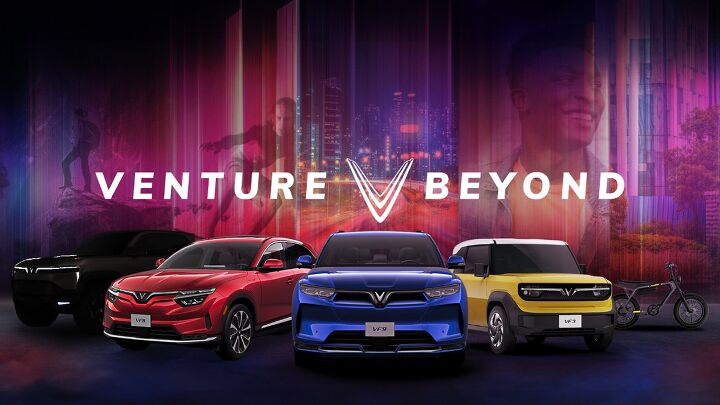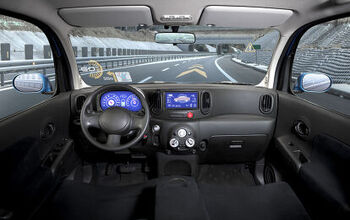VinFast Still Kicking and Planning to Show Vehicles at CES

VinFast Auto is planning to show off several electric vehicles at CES it would like to see sold within the United States in the coming years. Despite the brand initially looking like another automotive startup doomed to failure, it’s managed to outlast much of the competition and continues to express a desire to break into the North American market. Its booth will reportedly include the VF8 compact crossover, boxy VF3 microcar, and a new pickup concept.
Also on display will be the full-size VF9 SUV, which the company said will integrate a new streaming service CES attendees can experience personally, and an all-new electric bike.
The Vietnamese car company has only been around since 2017. But it has been building momentum quickly thanks to being a subsidiary of the multinational concomorate Vingroup. Originally founded in Ukraine as the Technocom food processing firm in 1993, Vingroup has branched out into just about every industry relevant in Southeast Asia. It is now Vietnam’s largest corporate entity by far — with loads of global business partners, an insatiable appetite for growth, and serious political influence.
This has led to VinFast working with Chevrolet to distribute vehicles on the Vietnamese market, garnered contracts for electric buses across Asia, and very nearly led it becoming the sponsor of the inaugural edition of the Formula One Vietnamese Grand Prix before the global pandemic response. But the ultimate goal is for VinFast to become a globally recognized EV manufacturer offering competitively priced vehicles.
To that effect, the brand will be putting products on display in Las Vegas next week for CES 2024. In fact, VinFast has been pretty consistent in terms of making an appearance at the trade show over the last several years.
The company typically showcases a few key models and then makes an announcement about how it’s gradually making headway toward U.S. sales, with this year apparently being no different. Shortly after VinFast confirmed its attendance at CES, it announced that it had officially signed agreements with five dealers in four states across the country to have them play host to its products.
From VinFast:
The first group of VinFast dealers consist of Leith VinFast (Raleigh, North Carolina), Smith Haven VinFast (St. James, New York), Principle VinFast Grapevine (Grapevine, Texas), Hiley VinFast of Fort Worth (Fort Worth, Texas), and VinFast Wichita (Wichita, Kansas). These dealers will initially begin selling the VinFast VF 8 all-electric SUV, with plans to add the VF 6, VF 7, and VF 9 models when they launch in the US market.
All VinFast customers who purchase or lease a VinFast electric vehicle are eligible for VinFast’s aftersales policies, including a 10-year/125,000-mile warranty for the vehicle and 10-year unlimited mileage for the battery under non-commercial use.
VinFast's local branch presently operates out of California with just over a dozen dealerships and service centers on hand. But it’s plotting to expand its U.S. network to include “125 points of sale” across the country.
“This is an important step affirming VinFast's commitment to expanding its retail sales network and shortening the time to deliver our products to market,” said Ms. Tran Mai Hoa, VinFast’s Deputy CEO of Sales and Marketing. “Collaboration with dealers allows VinFast to quickly bring US customers high quality electric vehicles, good prices and excellent aftersales policies, further promoting our mission of a sustainable future for all.”
Unfortunately for the brand, initial reviews of the VF8 were less than glowing. The car was accused of having all the modern tech inclusions people already find polarizing (touchscreen reliance, over-the-air updates, etc.) and executed them in a manner that rubbed testers the wrong way. Reviewers lambasted the vehicle’s interior and terrible suspension, with many suggesting that the car hadn’t undergone enough development to warrant public sales. We even have reports of unreliable navigation, basic controls failing, and throttle input delays that wouldn’t have been acceptable on a 40-year-old pickup.
But VinFast is still cutting its teeth and hoping customers will overlook some of that while it tries to get its ducks in a row. Still, initial impressions haven’t helped the brand in the United States and there have also been concerns that VinFast is to VinGroup what Evergrande Auto was to China’s Evergrande Group. People have grown quite skeptical about startups bankrolled by massive overseas entities and the same can be said about novice EV manufacturers following the financial shenanigans witnessed from brands like LeEco, Faraday Future, NIkola, and Lordstown Motors.
That said, VinFast has actually managed to build and sell automobiles — which is already further than most new automakers make it. It may not be fair to judge it based on industry skepticism, even if the feeling is wholly understandable. However, VinFast will absolutely need to improve its end products if it is to have any hope of being competitive in the United States.
Maybe what it’ll have on offer at CES next week will help alleviate any lingering doubts. At the very least, it’ll offer a glimpse of what might be in store for American car buyers. VinFast has also expressed its intention to sell extra-small EVs in the U.S. by way of the VF3 mini SUV, potentially cornering the sub $20,000 segment at a time when everyone is looking for what they hope will be a bargain.
[Images: VinFast]
Become a TTAC insider. Get the latest news, features, TTAC takes, and everything else that gets to the truth about cars first by subscribing to our newsletter.

A staunch consumer advocate tracking industry trends and regulation. Before joining TTAC, Matt spent a decade working for marketing and research firms based in NYC. Clients included several of the world’s largest automakers, global tire brands, and aftermarket part suppliers. Dissatisfied with the corporate world and resentful of having to wear suits everyday, he pivoted to writing about cars. Since then, that man has become an ardent supporter of the right-to-repair movement, been interviewed on the auto industry by national radio broadcasts, driven more rental cars than anyone ever should, participated in amateur rallying events, and received the requisite minimum training as sanctioned by the SCCA. Handy with a wrench, Matt grew up surrounded by Detroit auto workers and managed to get a pizza delivery job before he was legally eligible. He later found himself driving box trucks through Manhattan, guaranteeing future sympathy for actual truckers. He continues to conduct research pertaining to the automotive sector as an independent contractor and has since moved back to his native Michigan, closer to where the cars are born. A contrarian, Matt claims to prefer understeer — stating that front and all-wheel drive vehicles cater best to his driving style.
More by Matt Posky
Latest Car Reviews
Read moreLatest Product Reviews
Read moreRecent Comments
- Dartdude Having the queen of nothing as the head of Dodge is a recipe for disaster. She hasn't done anything with Chrysler for 4 years, May as well fold up Chrysler and Dodge.
- Pau65792686 I think there is a need for more sedans. Some people would rather drive a car over SUV’s or CUV’s. If Honda and Toyota can do it why not American brands. We need more affordable sedans.
- Tassos Obsolete relic is NOT a used car.It might have attracted some buyers in ITS DAY, 1985, 40 years ago, but NOT today, unless you are a damned fool.
- Stan Reither Jr. Part throttle efficiency was mentioned earlier in a postThis type of reciprocating engine opens the door to achieve(slightly) variable stroke which would provide variable mechanical compression ratio adjustments for high vacuum (light load) or boost(power) conditions IMO
- Joe65688619 Keep in mind some of these suppliers are not just supplying parts, but assembled components (easy example is transmissions). But there are far more, and the more they are electronically connected and integrated with rest of the platform the more complex to design, engineer, and manufacture. Most contract manufacturers don't make a lot of money in the design and engineering space because their customers to that. Commodity components can be sourced anywhere, but there are only a handful of contract manufacturers (usually diversified companies that build all kinds of stuff for other brands) can engineer and build the more complex components, especially with electronics. Every single new car I've purchased in the last few years has had some sort of electronic component issue: Infinti (battery drain caused by software bug and poorly grounded wires), Acura (radio hiss, pops, burps, dash and infotainment screens occasionally throw errors and the ignition must be killed to reboot them, voice nav, whether using the car's system or CarPlay can't seem to make up its mind as to which speakers to use and how loud, even using the same app on the same trip - I almost jumped in my seat once), GMC drivetrain EMF causing a whine in the speakers that even when "off" that phased with engine RPM), Nissan (didn't have issues until 120K miles, but occassionally blew fuses for interior components - likely not a manufacturing defect other than a short developed somewhere, but on a high-mileage car that was mechanically sound was too expensive to fix (a lot of trial and error and tracing connections = labor costs). What I suspect will happen is that only the largest commodity suppliers that can really leverage their supply chain will remain, and for the more complex components (think bumper assemblies or the electronics for them supporting all kinds of sensors) will likley consolidate to a handful of manufacturers who may eventually specialize in what they produce. This is part of the reason why seemingly minor crashes cost so much - an auto brand does nst have the parts on hand to replace an integrated sensor , nor the expertice as they never built them, but bought them). And their suppliers, in attempt to cut costs, build them in way that is cheap to manufacture (not necessarily poorly bulit) but difficult to replace without swapping entire assemblies or units).I've love to see an article on repair costs and how those are impacting insurance rates. You almost need gap insurance now because of how quickly cars depreciate yet remain expensive to fix (orders more to originally build, in some cases). No way I would buy a CyberTruck - don't want one, but if I did, this would stop me. And it's not just EVs.





































Comments
Join the conversation
"Trust us - before we sell one more car, we will get all of the throttle, steering, suspension, navigation, safety aid, and dynamic problems all worked out so everyone has a smooth and safe driving experience!"
Meanwhile...it just drove into a pole by itself!
I remember one reviewer saying the VF8 wallowed so much he was nearly barfing.
I don't know - it seems the best way to sell a Communist car in the US is to slap a Buick badge on it. Oh wait, a bunch of Buick dealers took the buyout. Never mind.
American consumers seem OK with US-branded products from China and Vietnam, but suspicious of those nation's brands themselves.